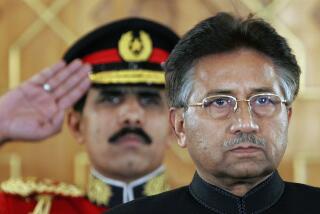Portraits Go Unsold 2 Months After Death : Memories of Zia Fade Quickly in Pakistan
- Share via
RAWALPINDI, Pakistan — The Zia posters are not selling anymore in the Rajah bazaar.
“We can’t even give them away these days,” sighs Zahoor ul-Islam Bhatti, proprietor of a print shop in the bazaar, as dust gathers on dozens of posters bearing the portrait of the late President Zia ul-Haq superimposed on drawings of a Muslim mosque and an American jet fighter.
Bhatti pointed to a slick, 1989 Zia calendar, priced at 5 rupees, or about 30 cents, and added: “I sold about 1,000 of these the first week after Zia died. But after that, nothing.
“We sold more than 250,000 of them to the Afghan moujahedeen (rebels), and they’re still selling well in Afghanistan. Zia is still a big hero to the moujahedeen . But in Pakistan, well, he was a hero for just one week.”
Only two months after Zia was killed in a plane crash, Pakistan’s longest-serving military ruler appears to be a fading memory.
His name was back on the front pages of newspapers after the government released a report Sunday on its investigation of the Aug. 17 crash, blaming sophisticated sabotage of the presidential plane, but interest died out quickly.
In recent weeks the Pakistani strongman’s memory has been confined largely to the narrow constituencies on which he concentrated his efforts.
In the mosques, he continues to be revered as a martyr who made Islam a cornerstone of his policies. He is still highly regarded by the military, and he still has influence among a handful of parties courting the so-called Zia loyalist vote in elections scheduled for Nov. 16.
Derision, Relief
But his photograph is no longer seen on the walls of government offices. His name is rarely heard in the tea stalls these days, and when it is, it is often coupled with derision or relief that he is gone.
According to some analysts, this should not come as a surprise. Zia seized power in a military coup in 1977, and he harshly punished his many critics--chief among them the politicians he overthrew and the media, which he silenced for many years.
“In particular, it has been the press that has done a lot of Zia-bashing in recent weeks,” said journalist Hussain Haqqani, who was both a critic and a personal friend of Zia’s. “It is important to remember that Zia’s three main power bases were the three M’s--the military, the mosque and the market--and it is among those three groups that he is still largely remembered with reverence.”
But even in the Rajah bazaar, which is near the colonial-era building where Zia lived in the heart of Islamabad’s sister city, Rawalpindi, many traders who once spoke with awe of Zia now say they think little of their former hero.
Most Portraits Gone
In the week after Zia’s death, shops in the bazaar were plastered with his portrait. Now, virtually all the portraits are gone, and those that remain are in the poorer shops, or in those of people who were personally touched by Zia.
“Once I shook hands with the martyr,” cafe owner Majid Khan told a reporter. His place in one of the bazaar’s narrow lanes displays five portraits of the late president, including one of Zia in uniform with a fiery plane crash in the background.
Khan conceded that he is in the minority, and he pointed to his missing right leg by way of explanation.
“Zia ul-Haq looked after people like me,” Khan said. “He took good care of the disabled, the downtrodden and the poor. Once, on Eid (an important Muslim holiday), Zia gave me a hand-powered bicycle. One cannot forget such things.
“When Zia died, people all cried. They shouted, ‘He was a great man, a great president, a great martyr.’ But it is true: In one week, they started saying only bad things about him. The people have forgotten.”
Why? Khan smiled, sighed and replied:
“I don’t know. It is always that way.”
Harsh Critics in Press
It is the press that has been harshest in assessing the Zia era, which in the view of editors and writers destroyed most of Pakistan’s democratic institutions and violated basic human rights.
Zia’s role in funneling international aid to the rebels in neighboring Afghanistan has also been criticized. While weapons and other supplies were moved into Afghanistan through Pakistan, huge amounts of the raw material of heroin came out, en route to market in the United States and Europe. In the process, the press here complains, Pakistan acquired more than 670,000 heroin addicts and tens of thousands of illegal firearms.
“There’s no question that Zia polarized much of the nation with his policies and approach,” a Western diplomat said, asking not to be identified by name. “Those divisions are very deep and will take years to go away. In the meantime, you’re going to see this bittersweet memory of the man linger.”
A Pakistani official, who also asked to be anonymous, thinks the elections, which promise to be Pakistan’s freest and fairest ever, have eclipsed Zia’s memory.
“On the face of it,” he said, “it does appear that Zia is fading away, but it is just that events after his death have happened so fast. His death has been clouded by election fever, and that is overshadowing everything else.
“Memories of Zia will come back only if the primary thing he was pushing--decency in politics--comes to pass. That is the thing for which the people will remember Zia, provided the government that comes to power after Nov. 16 is respectful of that decency.”
More to Read
Sign up for Essential California
The most important California stories and recommendations in your inbox every morning.
You may occasionally receive promotional content from the Los Angeles Times.












